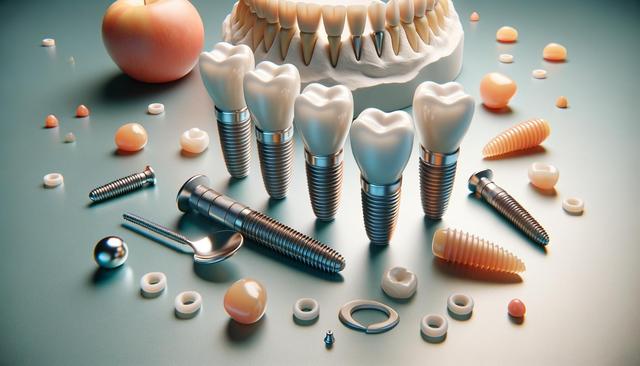Understanding Dental Implants
Dental implants are artificial tooth roots that provide a permanent base for fixed or removable replacement teeth. Designed to mimic the function and appearance of natural teeth, implants are typically made from titanium, a biocompatible material that integrates well with the jawbone. The procedure involves surgically placing the implant into the jaw, followed by a healing period during which the implant fuses with the bone — a process known as osseointegration.
Implants offer a long-lasting and stable foundation for dental prosthetics, such as crowns or bridges. They are often recommended when one or more teeth are missing, and they serve both functional and aesthetic purposes. Unlike dentures, which may slip or require adhesives, implants remain securely in place, providing greater confidence and comfort for the wearer.
In addition to their durability, dental implants can help preserve jawbone density, which often deteriorates after tooth loss. This preservation supports facial structure and prevents the sunken appearance that can occur over time with missing teeth.
Candidates for Dental Implants
Not everyone is immediately eligible for dental implants. An initial consultation with a dental professional is necessary to evaluate the patient’s oral and overall health. Ideal candidates typically possess the following characteristics:
- Good general health and oral hygiene
- Sufficient jawbone density to support the implant
- No untreated gum disease or chronic conditions that could impair healing
- Non-smokers or those willing to quit smoking, as tobacco use can interfere with implant success
For individuals with bone loss in the jaw, additional procedures such as bone grafts may be required to create a suitable foundation for the implants. Advances in dental technology have made it possible for more patients to qualify for implants, even in cases where they were previously not considered suitable candidates.
Benefits Beyond Aesthetics
While many opt for dental implants to enhance their smile, the benefits extend beyond appearance. Implants restore the ability to chew and speak properly, which can be compromised by missing teeth. They also help maintain the alignment of surrounding teeth by filling in gaps, preventing them from shifting over time.
Additional advantages include:
- Improved oral hygiene, as implants do not require neighboring teeth to be altered
- Enhanced self-esteem and confidence
- Long-term value due to their durability and low maintenance
- Reduced risk of cavities in adjacent natural teeth
Combined with other dental solutions such as removable braces, implants can contribute to a comprehensive smile makeover. While removable braces focus on aligning teeth, implants address the structural gaps, allowing patients to achieve both straight and complete smiles.
Comparing Implants with Other Replacement Options
Dental implants are often compared with alternative tooth replacement methods such as bridges and dentures. Each option has its own set of advantages and considerations. For instance, traditional bridges rely on adjacent teeth for support, which may require healthy teeth to be filed down. Dentures, while non-invasive, can be less stable and may need periodic adjustments.
In contrast, dental implants offer greater stability and do not affect adjacent teeth. They tend to feel more natural and provide better chewing efficiency. Over the long term, implants often prove to be a more cost-effective solution due to their longevity and minimal maintenance requirements.
When deciding between options, patients should consider factors such as:
- Longevity and durability
- Comfort and functionality
- Impact on surrounding teeth
- Cost and insurance coverage
A dental professional can help weigh these factors and guide patients toward the most suitable treatment plan for their individual needs.
Integrating Implants with Orthodontic Solutions
In some cases, dental implants are part of a broader orthodontic treatment plan that includes removable braces. Removable braces are often used to correct misalignments and prepare the mouth for implant placement. By realigning teeth and creating proper spacing, these braces can ensure that implants are positioned optimally for both function and aesthetics.
This integrated approach can be especially beneficial in complex cases where both missing and misaligned teeth are present. Coordinating orthodontic and implant treatments allows for a more balanced outcome and can contribute to a healthier bite and improved facial symmetry.
Benefits of combining removable braces with implants include:
- Improved spacing and alignment before implant placement
- Reduced risk of implant complications due to misalignment
- Enhanced overall smile aesthetics
- Greater long-term oral health benefits
Patients interested in this dual approach should consult with both an orthodontist and an implant specialist to develop a comprehensive treatment strategy tailored to their unique dental goals.
Conclusion: A Path to a Functional and Beautiful Smile
Dental implants provide a reliable and natural-looking solution for individuals dealing with tooth loss. When combined with orthodontic treatments like removable braces, they can significantly enhance both the functionality and appearance of a patient’s smile. While the process may involve multiple steps and require a commitment to oral care, the results often offer lasting benefits that contribute to overall quality of life. For those seeking to restore confidence in their smile while maintaining long-term oral health, dental implants are a strong and well-regarded option worth considering.











